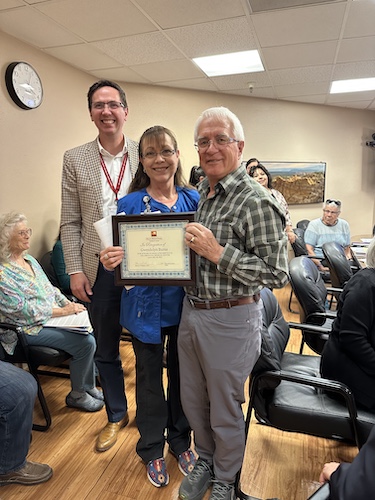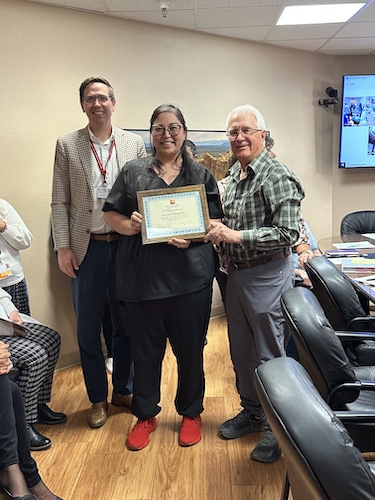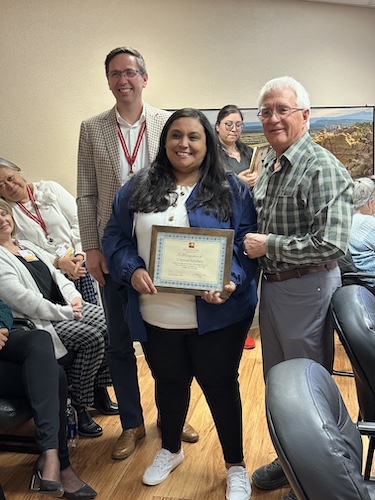By Mary Alice Murphy
After the general beginning items to each Gila Regional Medical Center Board of Trustees meeting, Chair Dr. Fred Fox presented the long list of the monthly recognitions for years of service to Gila Regional. They included ones from January and February.
He said: "I know from my long association with the hospital when I was in practice for many years of the significance that the staff in general, employees in general have at this hospital. I was always impressed by the dedication and caring attitude that our staff had. So I want to thank you all and the broader staff."
The first to be recognized for January was Jodie Giese for five years of service in case management, who was not present.
 The second was for Gwendolyn Burns for 15 years of service in nursing.
The second was for Gwendolyn Burns for 15 years of service in nursing.
"This time," she said. "If I had not left and had stayed, it would have been 42 years."
GRMC Chief of Staff Dr. Colicia Meyerowitz said: "When she's a supervisor, you don't know where you'll find her. I've seen her vacuuming in the hallways. She's told me to move over because she's emptying my garbage, and she goes to the pods and makes sure everyone has a break for lunch. So she really is who all nurses and all team members should aspire to be."
Board Member Gail Stamler, who retired from nursing at GRMC, said: "I second that comment."
Not present for the January award was Amedeo Ferruccio for 25 years in physical therapy.
 For the February awards, Fox recognized Amanda Mondello for five years of service in nursing.
For the February awards, Fox recognized Amanda Mondello for five years of service in nursing. Also present for her recognition Marisa Gallardo has served five years in nursing.
Also present for her recognition Marisa Gallardo has served five years in nursing.
 Virginia Sanchez has served for five years in registration.
Virginia Sanchez has served for five years in registration.
 Also present for her recognition award was Yvonne Holguin for her 25 years of service in registration.
Also present for her recognition award was Yvonne Holguin for her 25 years of service in registration.
Those not present for their recognition awards included Geanna Gray for five years serving in information services; Nathaniel Huffman for serving five years in registration, now during the night shift; Lori Tatum for 10 years of service at Gila Family Practice; Pamela Villanueva also for 10 years of service at Gila Family Practice; and Satoko Goellner for 15 years of service in pharmacy.
During public input, a woman who serves as part of the committee for cooperation with the professional community, spoke about the presence of Alcoholics Anonymous in the community.. She began with the statement regarding the organization's anonymity policy and asked that no photos or name identification be put into the press. "The assurance of anonymity is essential in our efforts to help other problem drinkers who may wish to share our recovery program with us." She shared her story of recovery thanks to AA and her remaining sober for 42 years. She noted that a study out of Stanford comparing AA and other modalities, determined that AA was 20 to 60 percent more effective than others, and the financial savings amounted to thousands of dollars. She said they have flyers and presentations they would be happy to offer to any group who might be interested in knowing more about AA. She noted AA offers 17 meetings a week to groups in Silver City, the Mining District and the Gila area. She said, although AA is not affiliated with other groups, also offered in the area are 12-step meetings, including Narcotics Anonymous and Overeaters Anonymous and Al Anon and for adult children of alcoholics. She handed flyers and business cards to GRMC staff and thanked everyone for their time.
The next public input came from a GRMC hospitalist. Dr. Tsering Sherpa. "I wanted to introduce myself and talk a little bit about my experience working here in the hospital since the beginning of this program. It has been an amazing 16 years for me working for this hospital for Emergency Staffing Solutions. Yes, we have had challenges along the way, but, you know, not something that we couldn't overcome with the help of our community physicians and with the help of the administration. And I know that the same company, ESS, took over the emergency room a little over a year ago, and there have been challenges with filling positions and spots. And I think we all know getting physicians to New Mexico has been challenging, even from the hospital standpoint. The community has really stepped in to help. Similarly, I know the administration and the community has been very supportive in the emergency room. What the hospital is doing, making changes, is definitely understandable for me, because my patients come first, regardless of anything else. I think, with just a few requests that ESS is willing to negotiate on what is needed given the challenges in the emergency room, I just don't want it to reflect negatively on the hospitalist side. We have had a very smooth ride up until now, and we don't want to make any changes. I love this community. I love my patients, I love the staff, I love the medical staff, and I love working with administration here. We have a great relationship. So really, that would be my request. And if anyone has any questions for me, please reach out to me, and thank you so much for giving me this platform to introduce myself and to talk to you."
Board Member Pat McIntire thanked the hospital for the banquet recognizing staff members the week before. "I would like to comment that I can attest to the fact that Gila Regional does provide exceptional quality patient-centered care in a healing environment. Even my husband told the nurse that."
Board members approved the consent agenda, which consisted of regular meeting and committee meetings minutes.
With no old business, they addressed new business. The first considered an amendment to renew for three years a master services agreement for outpatient rehab electronic health records with NetHealth. Board Vice Chair Betty Vega asked if the hospital was satisfied with the the agreement, to which she received an affirmative that it has worked well.
Members approved the renewal.
The second item considered a subscription services agreement for two years with Human Resources Information Services Platform to replace their current system with UKG. The human resources director said UKG had not worked well with the hospital situation, and she had talked to three other vendors and determined that this one would work the best at the best cost.
Members approved the agreement, after Interim Chief Financial Officer Leonard Binkley said it would be more efficient.
Next came reports and updates, with Chief Nursing Officer Ron Green presenting the first one. He said the new beds had arrived the previous Friday, and they have been distributed throughout the facility. He noted that beyond positive things like comfort, "the new beds will also offer another level of safety features for our patients as well." Some of the features will also assist the nurse.
Another project would begin on March 12, the startup phase for the nurse call system, which will integrate with some features for other staff as well, he said.
Green said the inpatient director at the hospital was interim at that time, but they had done interviews earlier in the month and made an offer. She had accepted the offer and was projected to start around the first of April. "We're excited to get a permanent director and definitely move forward."
The next report came from Binkley.
"We had a good financial performance in January, with strong outpatient better than budget and up by $1.2 million to prior year," Binkley reported. He also noted that strong inpatient volume was down to budget but up to prior year. Surgical volume also was down to budget but up to prior year. Emergency Room volume was up to both budget and prior year.
He reported that Gila Regional had 108 discharges, 7 percent below budget but up to prior year by 9 percent. Surgeries for January stood at 239, which was down to budget by 9 percent, but up to prior year by 5 percent. Outpatient volume revenue came from 5,476 visits, about 177 visits per day. It was up to budget by 202 visits, 4 percent and up to prior year by 288, 6 percent. ER visits totaled 1,395, about 45 visits per day, down for the fiscal year, which has had an average of 46 per day.
Binkley said the hospital had a good financial performance, with the bottom line, the surplus line at $307,000, without the receipt of government funds. "That's up to budget and up to the prior year." The gross revenue was at $22.6 million, up by $1.6 million to budget and up from the prior year. The other operating revenue line is the governmental fund where SB (Senate Bill) 161 and HDAA (Health Care Delivery and Access Act), the amount is $4.1 million, but the HDAA is accrual, so the hospital has not received those funds yet.
On total operating expenses, they were at $9.1 million. He noted the hospital is putting money into its permanent employees with a raise and as a result reducing its contract labor.
EBITDA (earnings before insurance, taxes, debt and amortization) was $3.2 million up to budget and up to prior year. The net surplus was $2.8 million up to budget for the month and for the year. "Overall, performance is better than budgeted and better than prior year. For the fiscal year, we see a much better financial performance. The gross revenue line is at $60 million, which is over budget, due to outpatient revenue. Total operating expenses for the fiscal year $55.3 million."
On key liquidity measures, he noted that net AR (accounts receivable) is better than budget and up to the prior year at current ratios of $4.5 million, better than prior year and better than other critical access hospitals. He said the average payment period is 89 days, better than prior year and better than other critical access facilities. He said the days of cash on hand was 157, also better than prior and other CA hospitals.
Vega asked: "Given the political climate, how are we planning for a possible cut in government funding? We need a Plan B."
Binkley said it was a good question and that he works with the CPA firm doing the hospital cost report, and "we want to err on the side of being conservative. So these are conservative estimates. We are reducing contract labor, increasing salary increases to employees, and we are receiving the opinion of professionals. We are kind of doing a continuous analysis. I think we are staying on top of it. The first thing we need to determine is how bad it could be in terms of loss of revenue. Then we can start some planning. Medicaid is one target for cuts, but our state tends to support Medicaid. It's really just taking that first step and determining the potential damage. So that's the best information we have tonight. We'll give updates, but it's a work in progress."
The next report came from the Chief Executive Officer Robert Whitaker. He thanked Vega for bringing up the question. He noted that Congress had proposed a bill to reduce Medicaid by !80 billion over 10 years. "That's if it passes." He noted that Gov. Michelle Lujan Grisham had noted they didn't know how it would impact New Mexico if it goes through. Whitaker also noted that they have received "radio silence" on federal grants such as the one for the MRI. He said they would move forward on other grants that are in progress, but the MRI funding "now seems uncertain."
"We are much farther along with the HVAC system," Whitaker said.
He said that a new software called Board Effect would streamline the board members being able to access documents and such.
Whitaker also has accepted a board position for the southwest portion of the New Mexico Hospital Association.
In addition, the hospital has contracted with a new company to manage employee benefits. "What we want to do as an organization is put together a good, robust, comprehensive, kind of a wellness plan for our employees."
He gave an update on bills that passed in the state legislative session that would relate to hospitals. Whitaker said the governor had announced a $1 billion behavioral health trust fund, with 5 percent of it being used each year to support behavioral health services and a variety of things. The 5 percent is $50 million a year. Several things are already in the works, he said. There was the behavioral health transports program that was created by hospital services corporation using a grant from the Healthcare Authority. They started with an I-40 corridor area that has proved successful. Next they plan to address the southern corridor.
Other bills under consideration related to recruitment and retention of healthcare workers as well as a variety of credential of physicians and clinical staff. A lot of the increased tax credits would positively impact healthcare workers to include EMTs, paramedics, occupations therapists and others. Other bills might limit attorney fees and punitive damages, as well as requiring transparency in litigations.
The representative from HealthTech, the hospital management company, spoke next. He reminded the board members of the annual conference, which would take place in September. He also noted the company has joined sort of an informal association with a group called Learn, Design, Apply. "We've found that in the past, many of our hospitals have been applying for grants themselves, and we want to try and find a manner in which applying for grants can be done in a more efficient manner, and we can try and apply for grants which we can spread across all of the hospitals within our portfolio. If we can do this, we feel confident that we are going to be able to deliver some of the grants, and it's also going to give us a greater chance of success of winning some of these grants."
Vega asked if it included the writing of grants and she received an affirmation of that.
Whitaker said he had already used the service with HRSA (Health Resources and Services Administration).
The HT representative said the chairman, accompanying him, would be giving a revenue cycle management report in the executive session.
The board then went into executive session. When they came out they approved:
The Medical Staff Executive Committee (MEC) provider credentialing reports;
• A three-year renewal of the employment agreement with Family Practice physician Stanley, John, M.D.;
• A three-year renewal of the employment agreement with Cardiologist Ratliff, Norman, M.D.
• A three-year renewal of the employment agreement with Family Practice Nurse Practitioner Moreno, Cynthia CNP;
• An amendment of the employment practitioner agreement to correct items in the original agreement with Family Practice physician Leslie, Steffanie, M.D.;
• An amendment of the employment practitioner agreement to add more work time with medical oncologist Durando, Michael M.D.; andDurando, Michael M.D.; and
• The 2025 Quality Assessment and Performance Improvement Plan.
The board adjourned.










